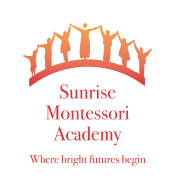Curriculum
Our Montessori classrooms have a large group gathering area which is used for circle time, musical activity, and rest. The Montessori classroom is set up in different subject areas: practical life, sensorial, mathematics, language, Social Science, and Art & Yoga.
 Practical Life: The exercises for practical life are designed to teach the child to function in their own environment by teaching them how to interact with the things around them. The practical life area prepares the child indirectly for all other areas of the curriculum with order, concentration, coordination and independence. Practical life exercises include pouring, sorting, food preparation, care of self (hand washing, teeth brushing, grooming), care of the environment (table washing, floor scrubbing, dusting, polishing). As the child progresses through the practical life work it becomes more involved. This is the easiest area of the classroom to bring to your home environment. Parents are encouraged to invite their child to sort the laundry. Show them how to load the washer and put in the appropriate amount of detergent. After the load of laundry is dry, your child can fold the laundry.
Practical Life: The exercises for practical life are designed to teach the child to function in their own environment by teaching them how to interact with the things around them. The practical life area prepares the child indirectly for all other areas of the curriculum with order, concentration, coordination and independence. Practical life exercises include pouring, sorting, food preparation, care of self (hand washing, teeth brushing, grooming), care of the environment (table washing, floor scrubbing, dusting, polishing). As the child progresses through the practical life work it becomes more involved. This is the easiest area of the classroom to bring to your home environment. Parents are encouraged to invite their child to sort the laundry. Show them how to load the washer and put in the appropriate amount of detergent. After the load of laundry is dry, your child can fold the laundry.
Sensorial: Sensorial exercises deal with developing the five senses and making comparisons between objects, to form judgments, to reason and to decide. Children explore gradations of color, dimension, and sound, tactile impressions, comparisons of smell and taste, geography, and geometry.Language: Language exercises train the child to focus on sounds and noises and to discriminate between them. Self-expression, writing, and reading flourish in the language area of the classroom.
Mathematics: With a focus on numeration, the decimal system, and geometry, this area of the classroom starts with very concrete material and moves to more abstract work. Each child moves at his/her own pace working to internalize concrete ideas and eventually shift to understanding abstract concepts.
Social Science: Social Science subjects include history, geography, art, physical science, music, and physical movement. The aim of studying culture is to allow the child to experience their place in the universe. They begin by exploring similarities between their culture and others, and then have appreciation and respect for differences. They learn how all beings are fundamentally related and discover ways to feel they are significant beings in this world.
Art & Yoga: Art is essential in the environment of the child from birth on. It is a way of approaching life, of moving and speaking, of decorating a home and school, of selecting toys and books. It cannot be separated from every other element of life. We cannot “teach” a child to be an artist, but we can help him develop:
An Eye that Sees
A Hand that Obeys
A Soul that Feels
We teach basic breathing and mediation to help children relax and exercise. Both yoga and Montessori build peace from the inside out.
